Text Patterns Structural aspects Narration: Relating Events
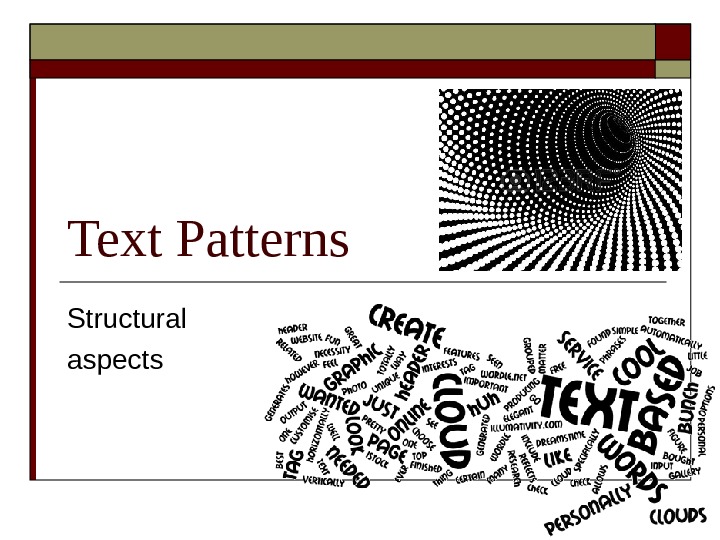
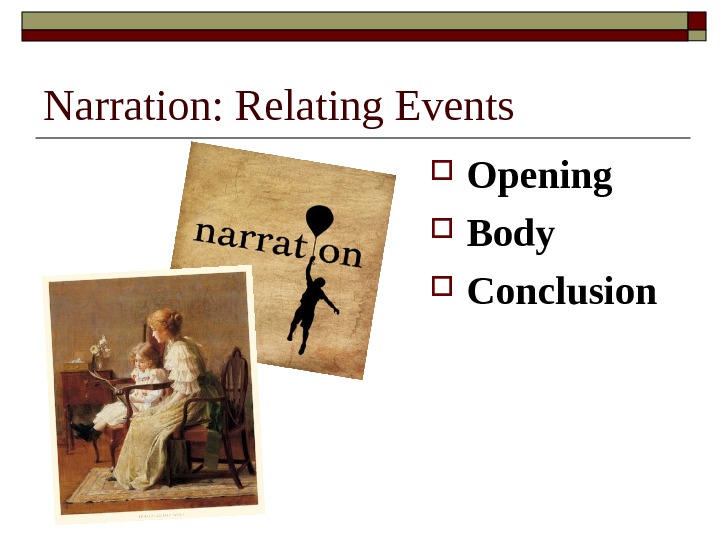
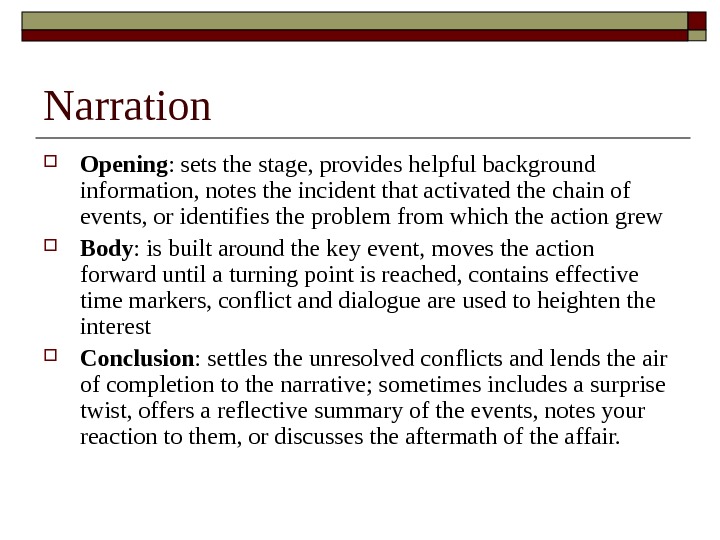

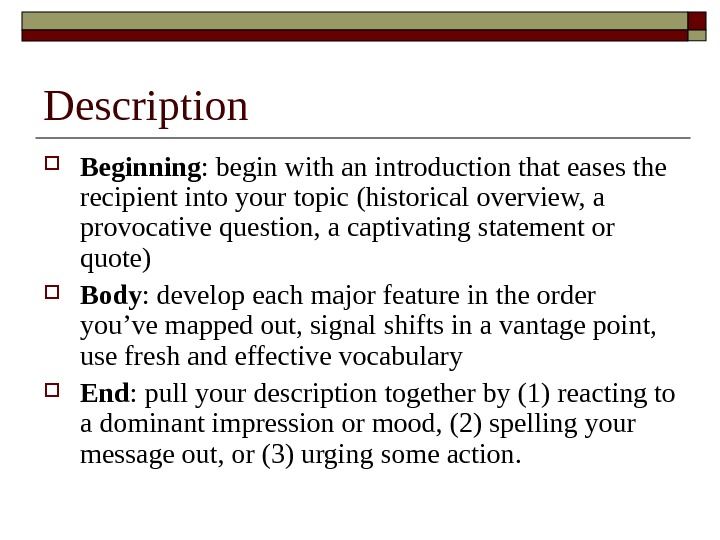

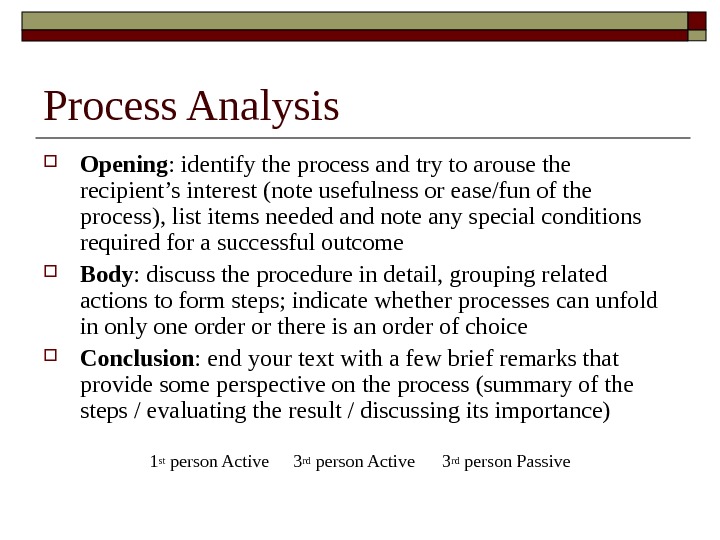

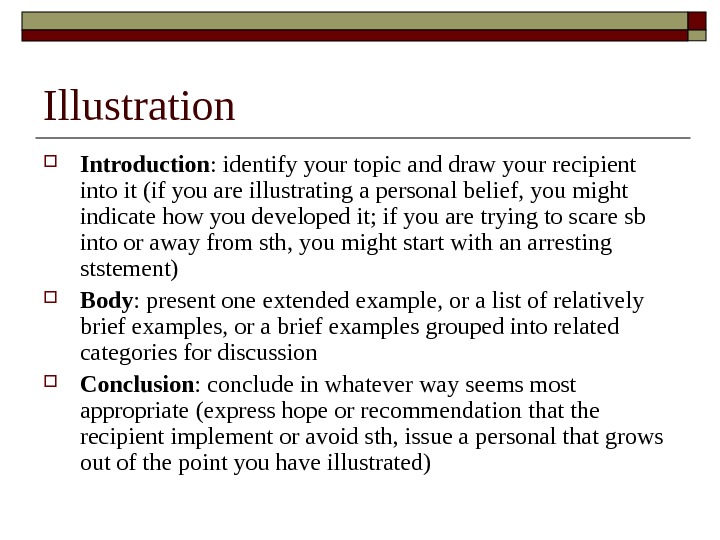
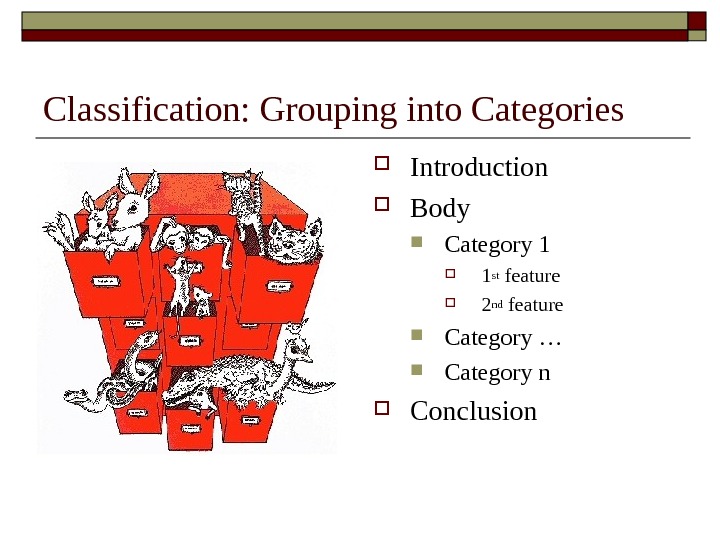

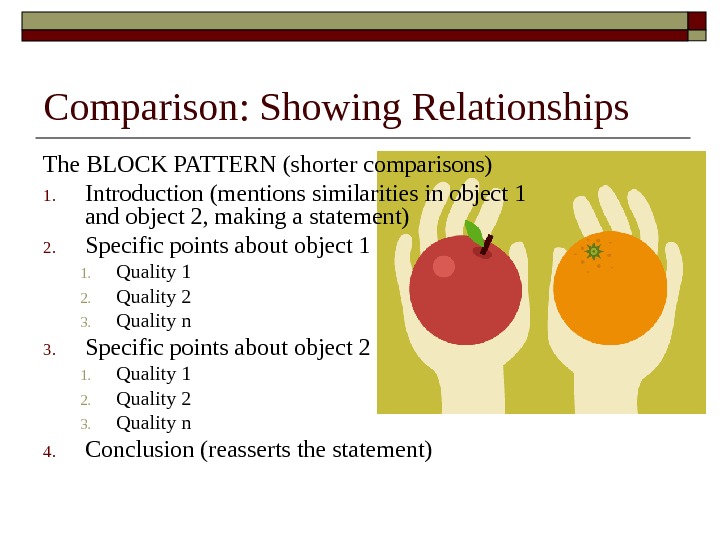

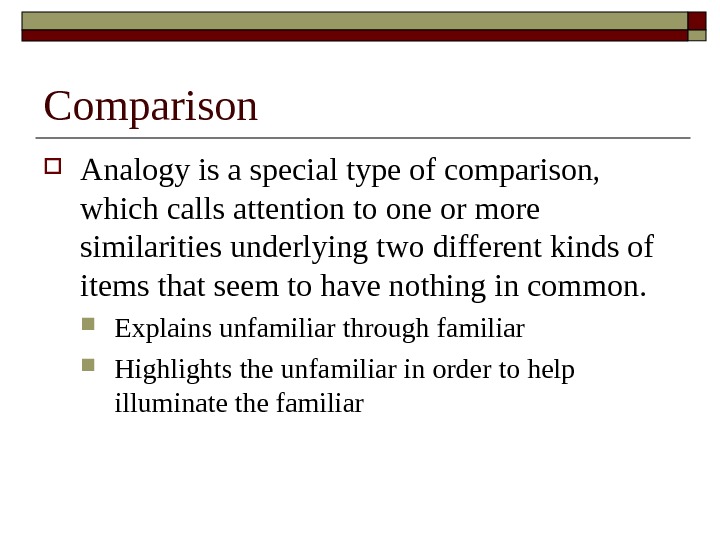
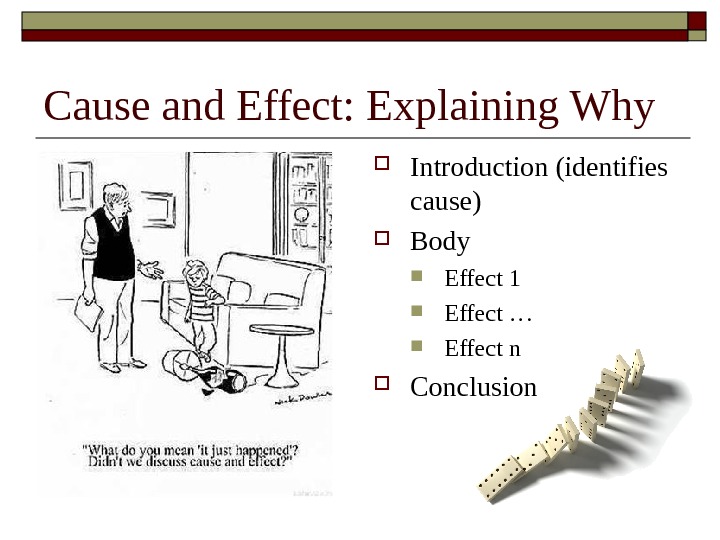


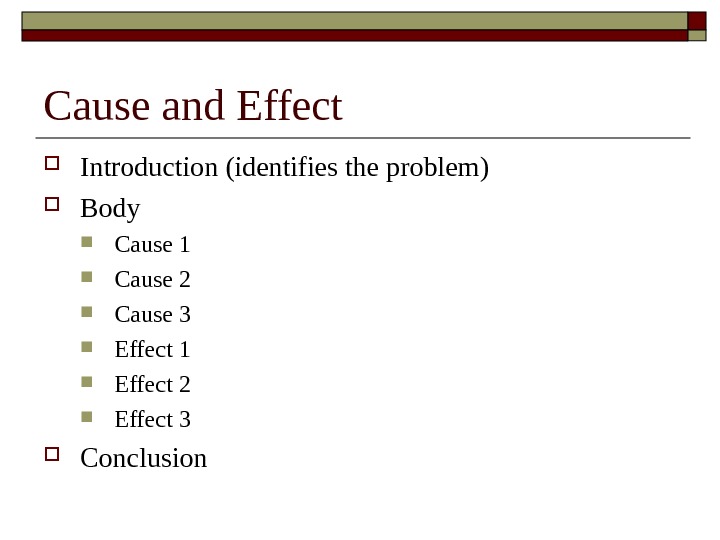
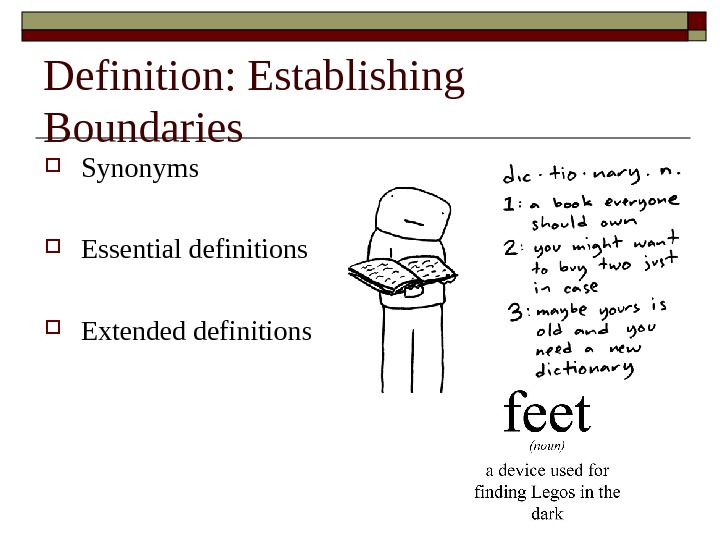
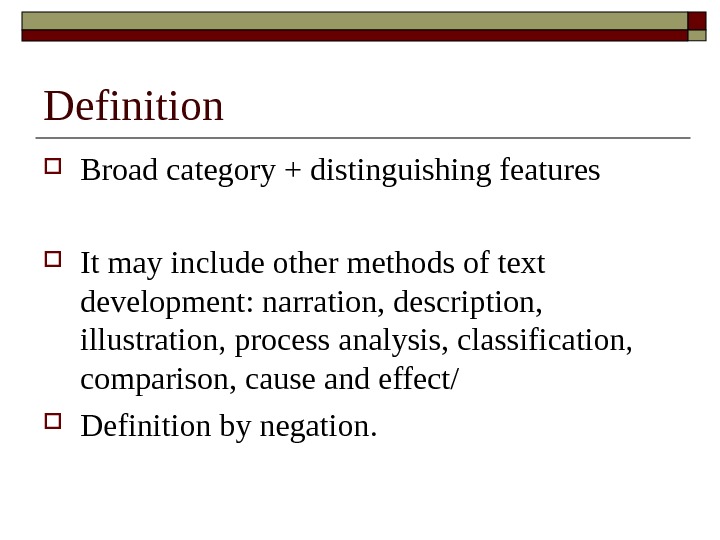
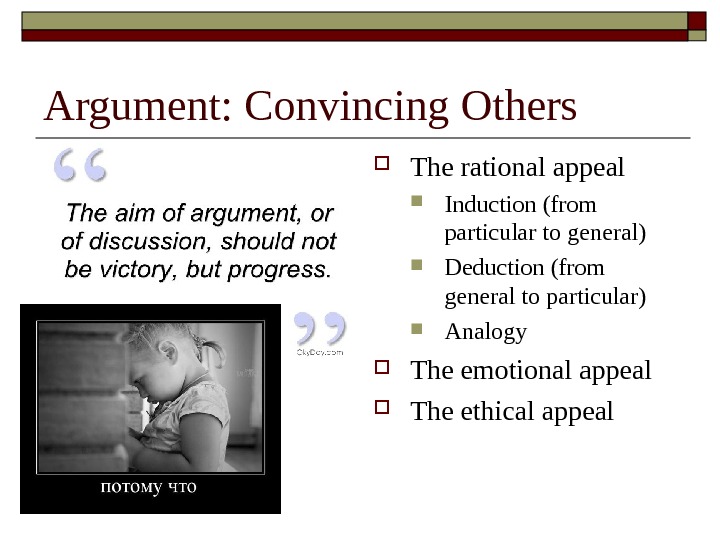
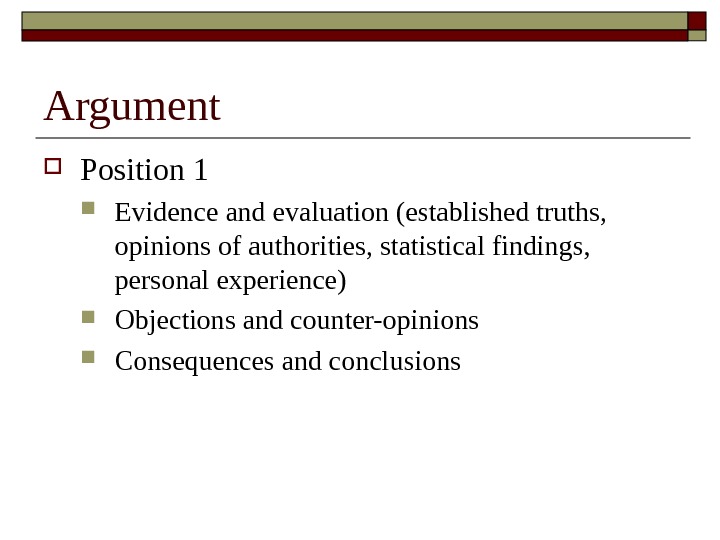
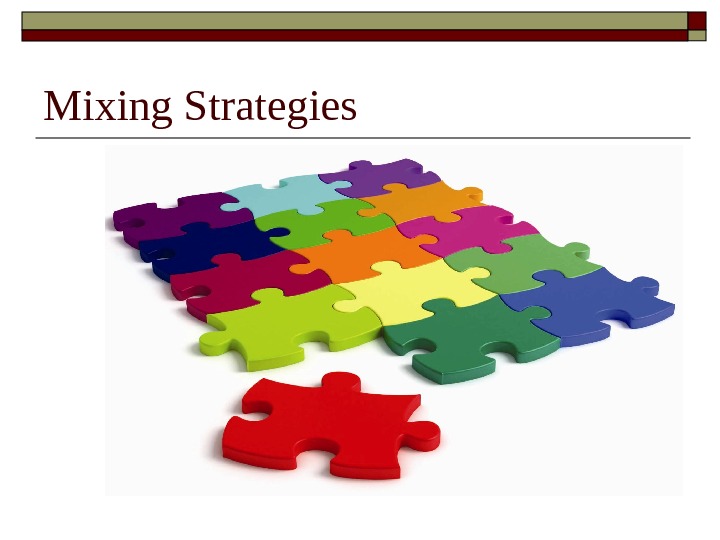
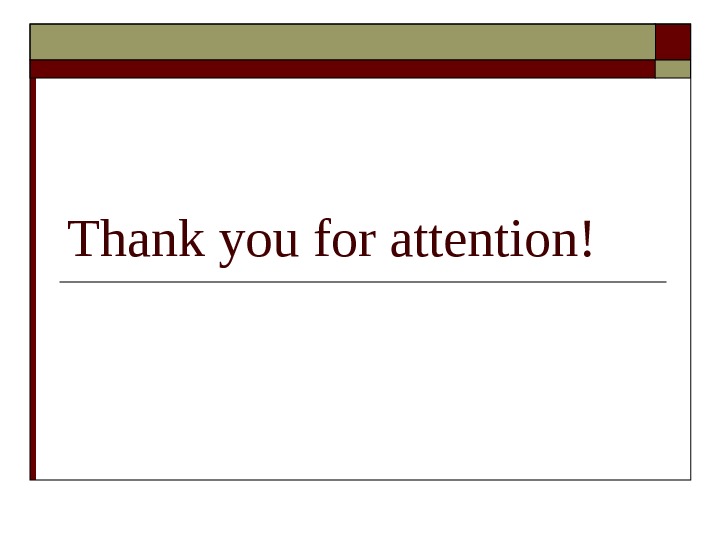
patterns_of_texts.ppt
- Размер: 1.6 Mегабайта
- Количество слайдов: 24
Описание презентации Text Patterns Structural aspects Narration: Relating Events по слайдам
 Text Patterns Structural aspects
Text Patterns Structural aspects
 Narration: Relating Events Opening Body Conclusion
Narration: Relating Events Opening Body Conclusion
 Narration Opening : sets the stage, provides helpful background information, notes the incident that activated the chain of events, or identifies the problem from which the action grew Body : is built around the key event, moves the action forward until a turning point is reached, contains effective time markers, conflict and dialogue are used to heighten the interest Conclusion : settles the unresolved conflicts and lends the air of completion to the narrative; sometimes includes a surprise twist, offers a reflective summary of the events, notes your reaction to them, or discusses the aftermath of the affair.
Narration Opening : sets the stage, provides helpful background information, notes the incident that activated the chain of events, or identifies the problem from which the action grew Body : is built around the key event, moves the action forward until a turning point is reached, contains effective time markers, conflict and dialogue are used to heighten the interest Conclusion : settles the unresolved conflicts and lends the air of completion to the narrative; sometimes includes a surprise twist, offers a reflective summary of the events, notes your reaction to them, or discusses the aftermath of the affair.
 Description: Presenting Impressions Beginning Body Feature # 1 … Feature # n End Important Elements Purpose Sensory impressions Dominant impression (overall mood) Vantage point Arrangement of details
Description: Presenting Impressions Beginning Body Feature # 1 … Feature # n End Important Elements Purpose Sensory impressions Dominant impression (overall mood) Vantage point Arrangement of details
 Description Beginning : begin with an introduction that eases the recipient into your topic (historical overview, a provocative question, a captivating statement or quote) Body : develop each major feature in the order you’ve mapped out, signal shifts in a vantage point, use fresh and effective vocabulary End : pull your description together by (1) reacting to a dominant impression or mood, (2) spelling your message out, or (3) urging some action.
Description Beginning : begin with an introduction that eases the recipient into your topic (historical overview, a provocative question, a captivating statement or quote) Body : develop each major feature in the order you’ve mapped out, signal shifts in a vantage point, use fresh and effective vocabulary End : pull your description together by (1) reacting to a dominant impression or mood, (2) spelling your message out, or (3) urging some action.
 Process Analysis: Explaining How Opening Body 1 st action/step (+ reason for action(s) + warning) … Nth action/step (+ reason for action(s) + warning) Conclusion
Process Analysis: Explaining How Opening Body 1 st action/step (+ reason for action(s) + warning) … Nth action/step (+ reason for action(s) + warning) Conclusion
 Process Analysis Opening : identify the process and try to arouse the recipient’s interest (note usefulness or ease/fun of the process), list items needed and note any special conditions required for a successful outcome Body : discuss the procedure in detail, grouping related actions to form steps; indicate whether processes can unfold in only one order or there is an order of choice Conclusion : end your text with a few brief remarks that provide some perspective on the process (summary of the steps / evaluating the result / discussing its importance) 1 st person Active 3 rd person Passive
Process Analysis Opening : identify the process and try to arouse the recipient’s interest (note usefulness or ease/fun of the process), list items needed and note any special conditions required for a successful outcome Body : discuss the procedure in detail, grouping related actions to form steps; indicate whether processes can unfold in only one order or there is an order of choice Conclusion : end your text with a few brief remarks that provide some perspective on the process (summary of the steps / evaluating the result / discussing its importance) 1 st person Active 3 rd person Passive
 Illustration: Making Yourself Clear Introduction Body Example / Group of Examples 1 st supporting detail 2 nd supporting detail Conclusion
Illustration: Making Yourself Clear Introduction Body Example / Group of Examples 1 st supporting detail 2 nd supporting detail Conclusion
 Illustration Introduction : identify your topic and draw your recipient into it (if you are illustrating a personal belief, you might indicate how you developed it; if you are trying to scare sb into or away from sth, you might start with an arresting ststement) Body : present one extended example, or a list of relatively brief examples, or a brief examples grouped into related categories for discussion Conclusion : conclude in whatever way seems most appropriate (express hope or recommendation that the recipient implement or avoid sth, issue a personal that grows out of the point you have illustrated)
Illustration Introduction : identify your topic and draw your recipient into it (if you are illustrating a personal belief, you might indicate how you developed it; if you are trying to scare sb into or away from sth, you might start with an arresting ststement) Body : present one extended example, or a list of relatively brief examples, or a brief examples grouped into related categories for discussion Conclusion : conclude in whatever way seems most appropriate (express hope or recommendation that the recipient implement or avoid sth, issue a personal that grows out of the point you have illustrated)
 Classification: Grouping into Categories Introduction Body Category 1 1 st feature 2 nd feature Category … Category n Conclusion
Classification: Grouping into Categories Introduction Body Category 1 1 st feature 2 nd feature Category … Category n Conclusion
 Classification Introduction : identify your topic and capture your recipient’s attention (modern state of affairs, anecdote, cite a personal experience, etc. ) Body : discuss your categories in whatever order best suits you (by importance, by categorizing principles); make sure that the arrangement of material within categories follows a consistent pattern Conclusion : may vary (prediction, recommendations, hope)
Classification Introduction : identify your topic and capture your recipient’s attention (modern state of affairs, anecdote, cite a personal experience, etc. ) Body : discuss your categories in whatever order best suits you (by importance, by categorizing principles); make sure that the arrangement of material within categories follows a consistent pattern Conclusion : may vary (prediction, recommendations, hope)
 Comparison: Showing Relationships The BLOCK PATTERN (shorter comparisons) 1. Introduction (mentions similarities in object 1 and object 2, making a statement) 2. Specific points about object 1 1. Quality 1 2. Quality 2 3. Quality n 3. Specific points about object 2 1. Quality 1 2. Quality 2 3. Quality n 4. Conclusion (reasserts the statement)
Comparison: Showing Relationships The BLOCK PATTERN (shorter comparisons) 1. Introduction (mentions similarities in object 1 and object 2, making a statement) 2. Specific points about object 1 1. Quality 1 2. Quality 2 3. Quality n 3. Specific points about object 2 1. Quality 1 2. Quality 2 3. Quality n 4. Conclusion (reasserts the statement)
 Comparison: Showing Relationships The ALTERNATING PATTERN (longer comparisons) 1. Introduction (mentions similarities in object 1 and object 2, making a statement) 2. Quality 1 1. Object 1 2. Object 2 3. Quality 2 1. Object 1 2. Object 2 4. Conclusion (reasserts the statement)
Comparison: Showing Relationships The ALTERNATING PATTERN (longer comparisons) 1. Introduction (mentions similarities in object 1 and object 2, making a statement) 2. Quality 1 1. Object 1 2. Object 2 3. Quality 2 1. Object 1 2. Object 2 4. Conclusion (reasserts the statement)
 Comparison Analogy is a special type of comparison, which calls attention to one or more similarities underlying two different kinds of items that seem to have nothing in common. Explains unfamiliar through familiar Highlights the unfamiliar in order to help illuminate the familiar
Comparison Analogy is a special type of comparison, which calls attention to one or more similarities underlying two different kinds of items that seem to have nothing in common. Explains unfamiliar through familiar Highlights the unfamiliar in order to help illuminate the familiar
 Cause and Effect: Explaining Why Introduction (identifies cause) Body Effect 1 Effect … Effect n Conclusion
Cause and Effect: Explaining Why Introduction (identifies cause) Body Effect 1 Effect … Effect n Conclusion
 Cause and Effect Introduction (identifies effect) Body Cause 1 Cause … Cause n Conclusion
Cause and Effect Introduction (identifies effect) Body Cause 1 Cause … Cause n Conclusion
 Cause and Effect Introduction (identifies the problem) Body Cause 1 Effect 1 Cause 2 Effect 2 Conclusion
Cause and Effect Introduction (identifies the problem) Body Cause 1 Effect 1 Cause 2 Effect 2 Conclusion
 Cause and Effect Introduction (identifies the problem) Body Cause 1 Cause 2 Cause 3 Effect 1 Effect 2 Effect 3 Conclusion
Cause and Effect Introduction (identifies the problem) Body Cause 1 Cause 2 Cause 3 Effect 1 Effect 2 Effect 3 Conclusion
 Definition: Establishing Boundaries Synonyms Essential definitions Extended definitions
Definition: Establishing Boundaries Synonyms Essential definitions Extended definitions
 Definition Broad category + distinguishing features It may include other methods of text development: narration, description, illustration, process analysis, classification, comparison, cause and effect/ Definition by negation.
Definition Broad category + distinguishing features It may include other methods of text development: narration, description, illustration, process analysis, classification, comparison, cause and effect/ Definition by negation.
 Argument: Convincing Others The rational appeal Induction (from particular to general) Deduction (from general to particular) Analogy The emotional appeal The ethical appeal
Argument: Convincing Others The rational appeal Induction (from particular to general) Deduction (from general to particular) Analogy The emotional appeal The ethical appeal
 Argument Position 1 Evidence and evaluation (established truths, opinions of authorities, statistical findings, personal experience) Objections and counter-opinions Consequences and conclusions
Argument Position 1 Evidence and evaluation (established truths, opinions of authorities, statistical findings, personal experience) Objections and counter-opinions Consequences and conclusions
 Mixing Strategies
Mixing Strategies
 Thank you for attention!
Thank you for attention!
